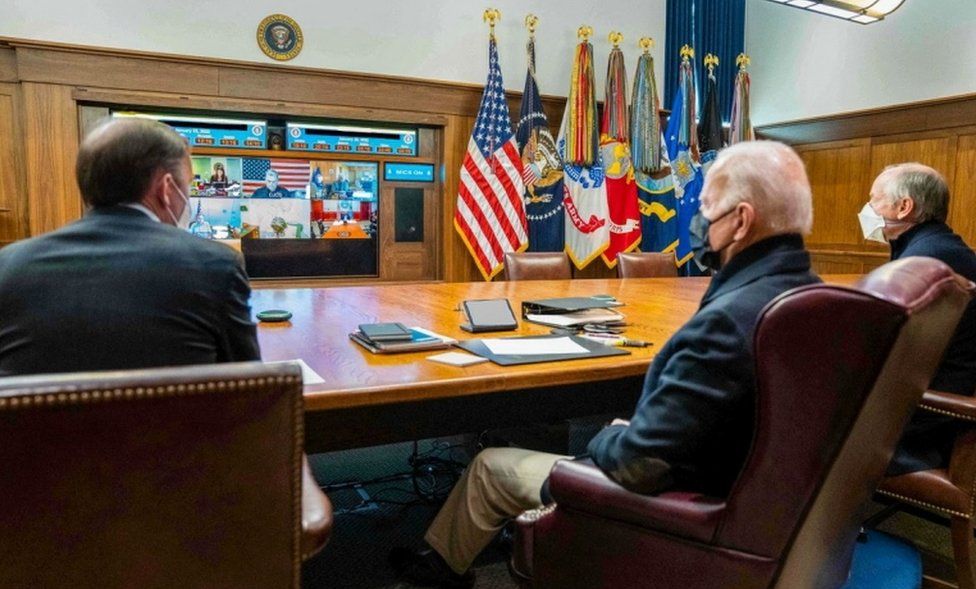US President Joe Biden will hold a video call on Ukraine with European allies later on Monday, after the US warned a Russian invasion could come “at any time”.
The leaders are expected to discuss their response to Russia’s troop build-up on its shared border with Ukraine.
Moscow continues to deny it is planning military action.
The Biden administration told relatives of its embassy staff to leave Ukraine on Sunday.
Ukraine said the decision was “premature”, calling it “a display of excessive caution”.
Monday’s call will include UK Prime Minister Boris Johnson, French President Emmanuel Macron, German Chancellor Olaf Scholz, Italy’s Prime Minister Mario Draghi, Polish President Andrzej Duda and Nato chief Jens Stoltenberg.
EU leaders Ursula von der Leyen and Charles Michel will also dial in.
Boris Johnson has today warned that “gloomy” intelligence suggests Russia is planning a lightning raid on the Ukrainian capital Kyiv.
“The intelligence is very clear that there are 60 Russian battle groups on the borders of Ukraine, the plan for a lightning war that could take out Kyiv is one that everybody can see,” he said.
“We need to make it very clear to the Kremlin, to Russia, that that would be a disastrous step.”
This video can not be played
To play this video you need to enable JavaScript in your browser.
The UK has also started withdrawing staff from its embassy, with about half of those working in the Ukrainian capital set to depart.
It comes a day after the UK Foreign Office accused Russian President Vladimir Putin of planning to install a pro-Moscow figure to lead Ukraine’s government.
The man named by the Foreign Office – former Ukrainian MP Yevhen Murayev – called the claims “stupid” in an interview with Reuters news agency, while Russia’s Ministry of Foreign Affairs tweeted that the Foreign Office was “circulating disinformation”.

Tensions over Ukraine
- EXPLAINED: Is Russia preparing to invade Ukraine?
- FROM KYIV: Ukrainians wait as Russia faces off with the West
- FROM BRUSSELS: EU ‘closest to war’ in decades over Russia-Ukraine crisis
- UK SUPPORT: UK says it is sending weapons to defend Ukraine

Over the weekend, some 90 tonnes of US “lethal aid” including ammunition for “front-line defenders” arrived in Ukraine.
US Secretary of State Antony Blinken said the government was putting together a “series of actions that would figure into [Russian] President [Vladimir] Putin’s calculus” including beefing up defences in Ukraine with more military assistance.
According to reports in the New York Times and CNN, the US is mulling a deployment of 1,000-5,000 troops to eastern Europe and the Baltic states, to counter the Russian deployment.
Members of the Nato military alliance, including Denmark, Spain, Bulgaria and the Netherlands, are already sending more fighter jets and warships to eastern Europe to bolster defences in the region.
When Mr Blinken met Russia’s Foreign Minister Sergei Lavrov for talks in Switzerland last week, the Russian expressed hopes that “emotions will decrease”.
Diplomatic wrangling has failed to ease tensions, however, and Russia’s currency – the rouble – has seen big falls in value. The US and its allies have threatened new economic sanctions if the Russian military moves against Ukraine.

The Kremlin has said it sees Nato as a security threat, and is demanding legal guarantees that the alliance will not expand further east, including into neighbouring Ukraine. But the US has said the issue at stake is Russian aggression, not Nato expansion.
Nato’s secretary-general Jens Stoltenberg has rejected Russia’s demand for a veto, saying the alliance stands “for the right of each nation to choose its own alliances”.
Russia has seized Ukrainian territory before, when it annexed Crimea in 2014. After Russian forces seized control of the territory, it voted to join Russia in a referendum the West and Ukraine deemed illegal.
Russian-backed rebels also control areas of eastern Ukraine near Russia’s borders. That conflict has cost an estimated 14,000 lives, with a 2015 peace deal a long way from being fulfilled.


























